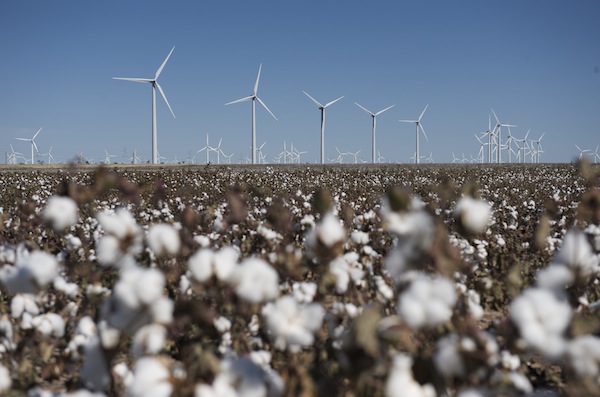SEJournal Online is the digital news magazine of the Society of Environmental Journalists. Learn more about SEJournal Online, including submission, subscription and advertising information.
Backgrounder: Will States, Locales Replace Feds on Climate Change?
By Joseph A. Davis
 |
|
Plans by Texas to build more coal-burning electric plants remain unrealized, while the state now leads in wind energy generation, such as at Horse Hollow Wind Energy Center, the world's largest wind farm [PHOTO: Danish Wind Industry Association, Flickr Creative Commons] |
The election of Donald Trump, a climate-change denier who vowed to “cancel” the Paris Agreement, has left many worrying about the planet’s future. But even if the federal government stops its own climate action, it appears state and local governments in many cases will push forward.
So the good news — at least for environmental journalists — is that there will only be more climate-related stories to localize. Non-federal climate stories have actually been around for a long time. Here are some sources and resources that can help you cover them.
One starting point is a Dec. 16, 2016, article by New York Times environmental reporter Tatiana Schlossberg finding that local governments are pushing ahead with climate action even as President-elect Trump reverses course. Jeff Biggers did another piece for the Times op-ed page along the same lines Nov. 30. And the paper’s editorial board declared Dec. 26 that “State governments will serve as an important bulwark against any attempt by [Trump] to roll back the progress the United States has made in addressing climate change.”
California pursues climate action, partnerships
Schlossberg’s article pointed prominently at California — long in the environmental vanguard, even under former Republican Gov. Arnold Schwarzenegger — where the legislature this year enacted a major new set of climate measures. The two measures tightened the targets in the state’s 10-year-old cap-and-trade program.
That legislation was only one example of many California climate initiatives. In December 2016, the California Energy Commission adopted ambitious energy-efficiency standards for computers and monitors, a move likely to improve efficiency far beyond California’s own borders.
The object lesson is that
the state and provincial politics
of energy and climate
present an ongoing story
of conflict, cooperation and change
It may be short-sighted to dismiss California’s program as merely state-level. California has the sixth-largest economy in the world, compared to actual nations. California’s market-based emissions trading system is second in size only to that of the European Union. Moreover, California has joined with the Canadian province of Quebec in an agreement to reduce emissions via trading.
The California-Quebec partnership emerged from a more complex arrangement called the Western Climate Initiative. Originally, the WCI began in 2007 as an initiative of the governors of five Western U.S. states (Arizona, California, New Mexico, Oregon and Washington). Eventually they were joined by two more U.S. states (Montana and Utah) and four Canadian provinces (British Columbia, Manitoba, Ontario and Quebec).
But in 2011, most U.S. states other than California withdrew from the WCI. This year, since Justin Trudeau won the Canadian prime minister post from fossil-friendly Stephen Harper in November 2015, Canadian provinces have been working out a more climate-friendly regime.
The object lesson for policy wonks (and journalists) is that the state and provincial politics of energy and climate are not monolithic and unchanging — whether under Trump or Trudeau. They present an ongoing story of conflict, cooperation and change which needs to be covered.
In Texas, economics took upper hand
There’s a story in Texas too.
This very red state is, of course, ground zero for the fossil fuel called oil, and has a hands-off regulatory doctrine to match. But look closely. In the mid-2000s, during the pro-coal Bush-Cheney administration, Texas planned to build some 17 new coal-burning electric generating plants — and then Republican Gov. Rick Perry vowed to fast-track their permits and mow down regulatory barriers. The Sierra Club’s “Beyond Coal” campaign to stop them seemed quixotic.
Cut to today. Most of those coal plants were never built — not because of regulatory barriers or political protests, but because of economics — and still more older Texas coal plants are shutting down in the near future.
One major culprit: not regulation, but cheap, fracked natural gas. Today, Texas has more wind energy than any other state. And solar is not far behind.
All of this happened on the watch of Perry, who to this day does not seem to believe in climate change. He did not, analysts say, lead this change; it happened largely in spite of him. Now he has been picked by Trump to be energy secretary.
Other states passing measures
In Michigan more recently, the Republican-controlled legislature passed a set of bills boosting renewable energy, and Republican Gov. Rick Snyder was expected to sign them.
The kicker: The package was supported by the Michigan Chamber of Commerce. At least two Michigan cities, Traverse City and Grand Rapids, have set goals to transition to all renewable power in the next five or ten years.
Illinois is another state that took some climate action this year. The state passed a bipartisan clean-energy jobs bill Dec. 1, 2016, which was then signed by Republican Gov. Bruce Rauner. Not all environmental groups liked the bill, though, because of subsidies for nuclear power and rate provisions affecting solar.
Other states taking climate action this year included Maryland, Oregon, Massachusetts, New York and Oregon.
In the end, the conflict is about
the politics of fuel — and it is natural gas,
not Obama’s Clean Power Plan,
that is eating coal’s lunch
In the United States, energy economies are often regional. Different fuels dominate different regions, creating different political environments.
The Regional Greenhouse Gas Initiative is essentially a carbon market for Northeastern states. It includes nine states: Connecticut, Delaware, Maine, Maryland, Massachusetts, New Hampshire, New York, Rhode Island and Vermont.
Signed in 2005, it became effective in 2009. New Jersey, under Republican Gov. Chris Christie, dropped out in May 2011. Yet the initiative has been functioning over the years as a cap-and-trade style emissions market, with proceeds going to fund renewable energy.
There are actually more multi-state climate initiatives in the United States. The Center for Climate and Energy Solutions lists them here.
Mixed picture in assault on Clean Power Plan
Many news accounts leave the impression that states overwhelmingly oppose the Clean Power Plan, President Barack Obama’s signature climate regulatory effort to reduce carbon dioxide emissions from old and new coal power plants.
About half the U.S. states are suing to overturn it. The case is currently in appeals court. Those states are led by Texas (home of energy secretary pick Perry) and Oklahoma (home of EPA administrator nominee Scott Pruitt), among others. This is hardly surprising, since both states are dominated politically by fossil fuel interests.
Yet fewer news accounts note that at least 18 states have entered the legal fray to support the plan, along with environmental groups, health advocates and renewable energy industries. And most among the states opposing the plan are already on track to meet its requirements.
That fact alone would bolster the idea that the opposition is based more on ideological and partisan grounds than economic ones. But the liberal Center for American Progress also notes that the industry groups opposing the plan in court are big polluters, and that their corporate balance sheets will be helped by continuing to pollute.
In the end, the conflict is about the politics of fuel — and it is natural gas, not Obama’s Clean Power Plan, that is eating coal’s lunch.
Keep an eye on moves by mayors
Whatever state or locality you are in, energy politics is the place to start. But do look beyond fuels and even jobs. The impacts (and economic damages) of climate vary by state as well.
For instance, climate-induced sea-level rise is already flooding parts of Florida, where the governor allegedly ordered state employees not to use the term “climate change” in official communications. Flooding from sea-level rise in Florida now threatens Mar-a-Lago, Trump’s oceanfront club on Palm Beach’s “billionaires row.”
You can find more about state-level climate impacts in the National Climate Assessment, from Climate Central, from the U.S. EPA or from the Center for Climate and Energy Solutions.
It’s important not to overlook the really local climate stories. The city of Portland, Ore., on Dec. 14 adopted a pioneering climate action strategy that uses zoning to ban virtually all new fossil-fuel (coal, oil and gas) shipping and storage infrastructure.
Portland is hardly alone. Since the November 2016 U.S election, 48 mayors have written Trump urging him to support city-led climate actions.
For more info, check the group called ICLEI (which translates its own acronym as Local Governments for Sustainability), an international network with a very active U.S. component.
Another worthwhile connection for local climate-action stories is the Compact of Mayors. Over 1,000 U.S. mayors have signed the U.S. Conference of Mayors Climate Protection Agreement, pledging to reduce carbon emissions in their cities. A list of them is here.
The city angle on climate may be adaptation and resiliency as much as prevention of climate change and sea-level rise by lowering emissions. Cities worldwide (not just Palm Beach) face tough changes. The C40 network of worldwide megacities has organized to meet the challenges — cities like Amsterdam, Cairo, Mumbai and Jakarta, certainly, but also including New York, New Orleans, Houston, Los Angeles and Boston. They met in Mexico City Nov. 30-Dec. 2, 2016.
* From the weekly news magazine SEJournal Online, Vol. 2, No. 1. Content from each new issue of SEJournal Online is available to the public via the SEJournal Online main page. Subscribe to the e-newsletter here. And see past issues of the SEJournal archived here.















 Advertisement
Advertisement 



